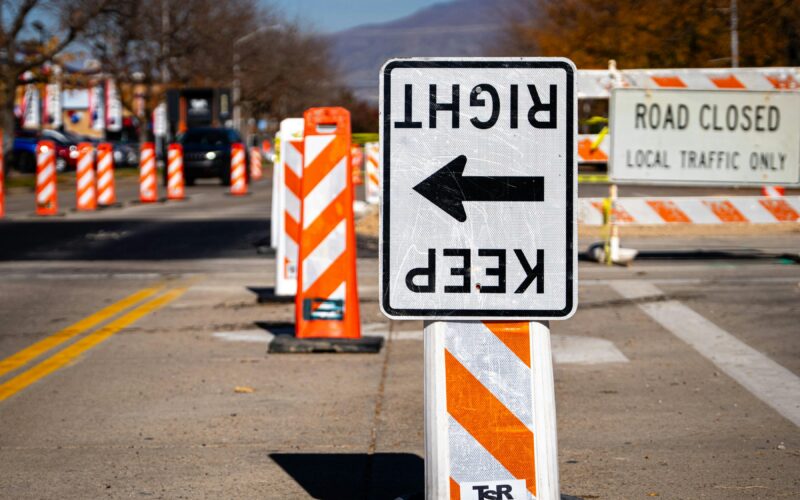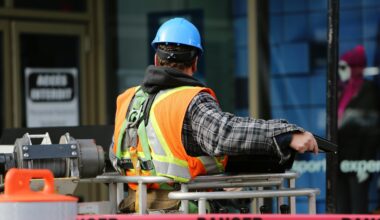Imagine walking onto a bustling construction site – cranes are in motion, workers are welding steel beams, and heavy machinery roars in the background. Amidst this controlled chaos, one thing remains clear: safety is paramount. But safety isn’t just about hard hats, gloves, or training programs; it also lies in something more straightforward yet vital – construction signs in US. These small, often overlooked markers hold the power to prevent accidents, protect workers, and save lives.
Whether you’re an experienced contractor, a construction worker, or someone who visits construction sites occasionally, understanding the significance of construction signs can be the difference between a safe workday and a severe injury.
In this article, we will dive into 15 crucial construction signs that every worker in the U.S. should know, how to interpret them, and why they are vital for maintaining a safe working environment.
Advertisements
1. Hard Hat Area (Warning) Sign
What it Means:
This sign indicates that the area you’re about to enter requires a hard hat. It’s typically displayed in areas with a risk of falling debris or overhead hazards.
Why It’s Important:
Falling objects are one of the leading causes of head injuries in construction. A hard hat provides vital protection, reducing the risk of life-threatening injuries. Ensure you always wear your hard hat in these zones, as ignoring this sign can result in serious head injuries.
Illustration: A bright yellow sign with a hard hat icon and the words “Hard Hat Area” displayed prominently.
Advertisements
2. High Voltage Sign
What it Means:
A high-voltage sign warns workers of electrical systems operating at dangerous voltages, such as power lines, transformers, and electrical equipment.
Why It’s Important:
Electrical accidents, including electrocution, are a significant risk on construction sites. High-voltage signs help prevent accidental contact with electrical sources that could result in severe burns, electrical shocks, or even fatalities. Always stay clear of any high-voltage zones unless adequately trained and equipped.
Illustration: A black-and-yellow striped sign with a high-voltage warning symbol.
3. Flammable Materials Sign
What it Means:
This sign marks areas where highly flammable or combustible materials are present. These could include fuels, chemicals, and certain gases.
Why It’s Important:
Flammable materials constitute a significant hazard in construction, primarily when workers handle chemicals or work with open flames. This sign reminds workers to keep ignition sources away and safely handle materials. Ignoring it could lead to catastrophic explosions or fires.
Illustration: A red and white sign with a flame icon symbolizing flammability.
4. Authorized Personnel Only Sign
What it Means:
This sign restricts authorized personnel access to certain construction site areas only. These areas might include dangerous zones or regions where specialized equipment is used.
Why It’s Important:
Restricting access to only qualified personnel helps minimize the risk of injury to workers who aren’t trained to handle specific hazards. Keeping unauthorized people out of potentially dangerous zones reduces the risk of accidents.
Illustration: A red sign with “Authorized Personnel Only” in bold, block letters.
5. Caution: Wet Floor Sign
What it Means:
This sign is typically found where floors are wet due to cleaning, water spills, or rain. It warns workers to be careful when walking to avoid slipping.
Why It’s Important:
Slips, trips, and falls are common causes of workplace injuries. This sign is a simple yet effective tool in preventing these accidents, alerting workers to hazards underfoot that may not be immediately visible.
Illustration: A yellow sign with a person slipping and the words “Caution: Wet Floor.
6. Construction Zone Sign
What it Means:
A “Construction Zone” sign marks an area where construction or demolition occurs. It’s a general warning that workers should proceed with caution.
Why It’s Important:
Workers face numerous risks in construction zones, including heavy machinery, unstable structures, and high noise levels. This sign ensures that anyone entering is aware of potential dangers and can take precautions.
Illustration: A bright orange sign with a construction worker graphic.
7. Eye Protection Required Sign
What it Means:
This sign indicates that workers must wear safety goggles or other eye protection when entering a specific area. This is common in zones where particles, chemicals, or debris will likely fly through the air.
Why It’s Important:
Eye injuries, ranging from minor irritations to permanent vision loss, are a common concern in construction. This sign reminds workers to protect one of their most valuable senses while on the job.
Illustration: A sign showing a pair of protective goggles with the words “Eye Protection Required.
8. Fall Hazard Sign
What it Means:
This sign indicates that the area poses a fall risk, often due to working at heights, near edges, or around holes in the ground.
Why It’s Important:
Falls are a leading cause of injury and death in the construction industry. This sign highlights areas where falls are likely, helping workers take precautions such as using fall arrest systems, guardrails, or other safety measures.
Illustration: A yellow triangle with an exclamation mark and a person falling.
9. No Smoking Sign
What it Means:
A “No Smoking” sign indicates areas where smoking is prohibited, often due to the presence of flammable materials or hazardous chemicals.
Why It’s Important:
Construction sites often have volatile substances that can ignite easily. Smoking in such areas could lead to fires or explosions, putting the entire site and workers at risk.
Illustration: A red circle with a cigarette and a line through it, symbolizing no smoking.
10. Gas Leak Hazard Sign
What it Means:
This sign alerts workers to a gas leak, indicating a significant risk of explosion or poisoning.
Why It’s Important:
If not adequately handled, gas leaks are hazardous and can cause fires, explosions, or asphyxiation. This sign is crucial in preventing these potentially deadly incidents and instructing workers to evacuate or take other safety precautions.
Illustration: A blue and white sign with a gas symbol, warning of a gas leak hazard.
11. Lifting Hazard Sign
What it Means:
A lifting hazard sign warns workers of the potential for injury when handling heavy materials or operating lifting equipment like cranes.
Why It’s Important:
Lifting heavy loads improperly can cause severe back injuries, strains, or even broken bones. This sign reminds people to use proper lifting techniques, safety gear, and equipment to reduce the risk of injury.
Illustration: A yellow and black sign with a person lifting an object and a caution symbol.
12. Hearing Protection Required Sign
What it Means:
This sign indicates that the noise level in the area exceeds safe limits and requires workers to wear ear protection.
Why It’s Important:
Prolonged exposure to loud noise can cause permanent hearing damage. This sign is essential in construction zones where heavy machinery and equipment generate harmful noise.
Illustration: A sign showing ear protection gear with the words “Hearing Protection Required.
13. Forklift Operating Area Sign
What it Means:
This sign designates areas where forklifts and other heavy equipment are in operation. It warns workers to stay alert and avoid walking in these zones.
Why It’s Important:
Forklifts are often involved in workplace accidents, particularly when workers don’t notice them or are caught in blind spots. This sign helps keep workers at a safe distance from machinery in motion.
Illustration: A forklift icon with caution markings indicating an active operating area.
14. Toxic Gas Hazard Sign
What it Means:
This sign alerts workers to toxic gases in the air that may be harmful if inhaled.
Why It’s Important:
Exposure to toxic gases can result in poisoning, respiratory problems, or even death. Recognizing this sign is vital for workers to take necessary precautions like wearing gas masks or evacuating the area.
Illustration: A yellow sign with a gas mask and a warning symbol.
15. Exit Sign
What it Means:
An exit sign marks the direction to the nearest safe exit in case of an emergency evacuation.
Why It’s Important:
Knowing where the nearest exit is can save lives in a fire, explosion, or other emergency. Construction sites, huge ones, often have complex layouts, so understanding where exits are located can be crucial for safe evacuation.
Illustration: A glowing green exit sign with an arrow pointing toward safety.
Construction Signs in US (Keeping Safety First on Construction Sites)
While one of the most rewarding industries, the construction industry also poses significant risks. However, by consistently using clear, visible construction signs, many risks can be minimized or avoided. These 15 construction signs, from hard hat areas to exit signs, serve as the unsung heroes of workplace safety. By taking them seriously and adhering to their warnings, workers can protect themselves and their colleagues from preventable injuries or fatalities.
Remember: Safety is not just a rule—it’s a responsibility. Ensure you are always vigilant, adequately equipped, and aware of your surroundings. After all, a safe construction site is a productive one.
Advertisements






